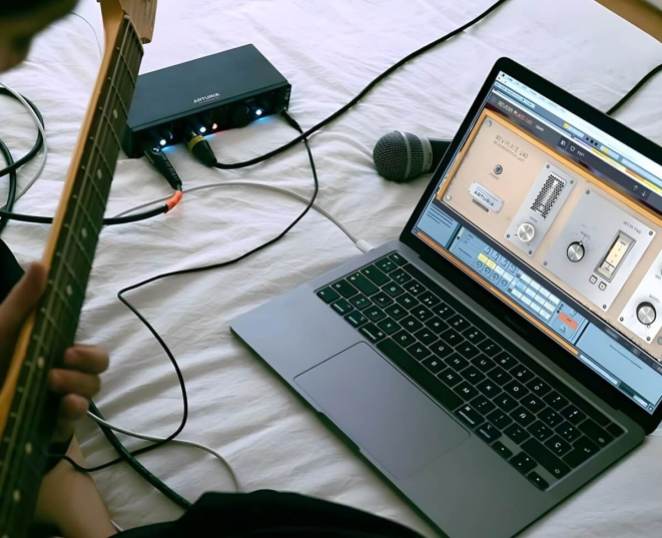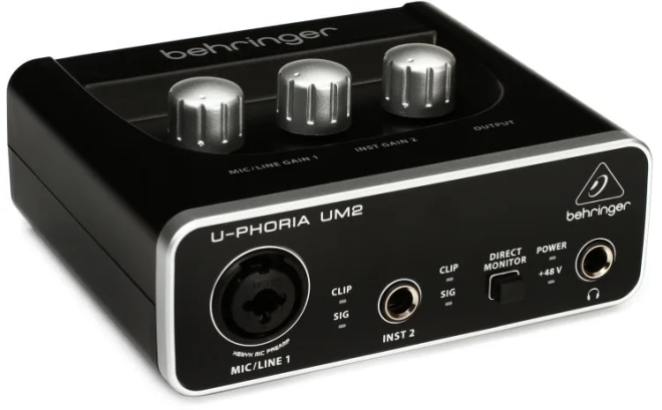When you buy through our links, we may earn an affiliate commission.
My recent tour in Japan made me realize the importance of having compact and reliable gear with me when traveling, and although I love my 4-in/4-out Behringer audio interface, having a smaller one would’ve simplified my life without sacrificing sound quality.
A smaller audio interface doesn't necessarily mean inferior quality: on the contrary, many modern interfaces come with features and software bundles that make them an all-in-one solution for artists of all levels, from the touring songwriter to the EDM bedroom producer.
Today we talk about the Arturia Mini Fuse 2, one of those audio interfaces that found the perfect balance between portability, great performance, and affordability. Whether you're out of space in your studio or moving around frequently with your gear, the Arturia Mini Fuse 2 could be an invaluable companion in your creative journey.
Brief Overview

Despite its compact size, the Arturia Mini Fuse 2 offers plenty of features to perform and record effortlessly. The wide dynamic range, combined with the possibility to switch between line and instrument levels, makes it a great option for singer-songwriters but also electronic producers who value minimal footprint.
It comes with two high-quality preamps, supporting up to 24-bit/up and 192kHz, +48V phantom power, a front-panel headphone output jack with independent volume control, a direct mono switch, and an input/USB mix knob for zero-latency direct monitoring and blend input signal between your instrument and the connected computer.
On the back of the audio interface, you’ll find IN/OUT 5-pin MIDI DIN I/O you can use for drum machines and synths connections and a USB-A hub port, reducing studio clutter and supporting MIDI controllers up to 250 milliamps.
The Arturia Mini Fuse 2 comes packed with various software and plugins, as well as its own control software, MiniFuse Control Centre. The software package you'll receive includes the Intro version of Arturia’s Analog Lab and four top-quality Arturia effects: Rev Plate-140, Pre 1973 vintage preamp, Delay Tape-201 echo, and Chorus Jun-6 analog chorus. You'll also get Native Instruments Guitar Rig LE and Ableton Live Lite, plus two three-month trial subscriptions to Splice Creator Plan and Auto-Tuner Unlimited.
All in all, it offers everything a beginner producer needs to make music on the go. The second input added to this version of the Mini Fuse expands the creative potential of this audio interface while preserving its space-saving characteristics.
The sound captured by the Arturia Mini Fuse 2 feels clear and professionally recorded, and through the MiniFuse Control Centre, you can monitor and personalize your recording experience.
Why I Like It:
- Portable and lightweight design, perfect for on-the-go recording.
- Professional recording and good-quality preamps.
- Versatile software bundle.
What I Think Could Be Improved:
- Great for songwriters, but for bands or electronic producers, there are better options at a similar price.
Features & Benefits

Portable Design (4.5/5)
The Arturia Mini Fuse 2 is designed with portability in mind. While its price and size might make you think otherwise, the audio interface feels sturdy and durable (the 5-year warranty that Arturia offers speaks volumes) and is wide enough to accommodate all the controls and channels you need and make them easy to adjust at a glance.
Great Preamps (4/5)
Arturia doesn't specify whether the Mini Fuse 2's preamps are inspired by vintage preamps. Yet they sound great to me: the recordings are clean and balanced, with excellent spatiality and plenty of headroom.
With a 110dB dynamic range and a good quality input noise of -129dB, this interface can easily capture every nuance of your performance with detail. Whether you're recording vocals, instruments, or synthesizers, the Mini Fuse 2 can achieve great results with the smallest of footprints.
Versatile Connectivity Options (4.5/5)
The Mini Fuse 2 comes packed with everything modern bedroom producers need. Two-input channels are great if you're a songwriter, but everyone who wants to record in stereo can benefit from a double input: have you ever tried to record a piano in mono and stereo to see the difference? The double input can open up a plethora of creative possibilities.
The real MIDI I/O is great for connecting electronic drums or synthesizers, while the USB hub will give you control over whichever MIDI controller you use to make music, so long as its power requirements are below 250mA.
The French brand Arturia definitely knows what modern producers need, and managed to pack everything necessary to produce high-quality music in a small audio interface that has it all. If that isn't enough, you can further adjust volume levels and more through the intuitive Control Centre Panel.
Included Software Bundle (4.5/5)

The aforementioned Control Centre Panel is a great feature that allows you to overview your recordings at a glance. There, you can check input levels, activate phantom power, and automatically update the audio interface’s drivers.
The Mini Fuse 2 also comes bundled with a comprehensive software package: Ableton Live Lite, Analog Lab Intro, and Arturia FX giving you access to a wide range of tools and effects to get you started or expand your sonic palette.
Overall Rating: (4.5/5)
Things to consider before buying the Arturia Mini Fuse 2:
Portability vs. Features
When buying music gear, it’s crucial to predict our requirements in the long term. If you ask me, I believe two jack inputs are not enough for musicians playing in bands or those who want to record most acoustic instruments professionally. But then again, I'm a drummer, so I am used to being surrounded by a dozen microphones whenever I'm in a studio.
However, if you’re a bedroom producer or beginner with just a MIDI keyboard, or a songwriter using condenser microphones to record music, the Mini Fuse 2 is an audio interface that might suit your needs perfectly. It’s incredibly intuitive, delivers good-quality audio, and has enough connectivity options to satisfy the needs of most solo artists.
Budget
The Mini Fuse 2 is, by all means, not an expensive audio interface, yet depending on your requirements, you might be able to spend a little less and still get everything you need for your music.
A single input might be enough if you’re a guitarist, vocalist, or electronic music producer who works mostly with virtual instruments and only needs a USB connection. If that’s the case, you might end up saving quite some money by getting a single-input interface (like the MiniFuse 1, for instance).
Check out our full roundup of the best budget audio interfaces for more options.
Compatibility
I think it’s safe to say that Arturia’s products are compatible with most, if not all, audio recording software and tools. However, it's always good practice to check online and see if the Mini Fuse 2 will work seamlessly with your DAW, MIDI instruments, and operating system.
As I said before, the Mini Fuse 2 is designed with beginner producers and traveling musicians in mind, so all-around versatility is one of its most crucial characteristics.
Alternatives
There are quite a few valid alternatives to the Mini Fuse 2, some of which will also allow you to save a few bucks.
Arturia Mini Fuse 2 vs. Focusrite Scarlett 2i2

The Focusrite Scarlett 2i2 is perhaps the most popular audio interface for beginners right now and for all the right reasons. It's reasonably priced, extremely intuitive, and comes packed with music software and plugins.
In terms of sound quality, both the Arturia Mini Fuse 2 and Focusrite Scarlett 2i2 offer pristine audio recordings and ample input options despite their size. My suggestion would be to check out what each of them offers in terms of bundles and choose accordingly. If you have limited space in your studio, the Mini Fuse 2 is slightly smaller, so that might be a decisive factor if a smaller footprint is important to you.
Check out our full review of the Scarlett range of interfaces for more details.
Arturia Mini Fuse 2 vs. PreSonus AudioBox USB 96

Beginners on a tight budget may prefer the AudioBox USB 96 since it costs less than $100 and does provide good performance for the money. However, recording up to 96kHz is a bit of a deal breaker for me, as I believe recording at higher kHz will enhance clarity and give you more headroom for post-production operations.
Arturia Mini Fuse 2 vs. Behringer U-Phoria UM2

Both the Mini Fuse 2 and Behringer U-Phoria UM2 are compact and affordable audio interfaces great for beginners and mobile recording setups. I've been using interfaces from the U-Phoria series for years now and am extremely satisfied with their performance, but aside from my personal experience, I think both interfaces can be a great addition to any home recording studio.
While the Mini Fuse 2 offers a more streamlined design and extra connectivity options, the U-Phoria UM2 is extremely cheap and comes with a complimentary copy of Tracktion DAW software. Once again, the choice is up to you and will depend on what you’re after in terms of bundles and budget.
See our full review of the Behringer U-Phoria to find out more.
Final Thoughts
The Arturia Mini Fuse 2 won’t change the game in the world of audio production, but it’s a reliable and affordable piece of gear that can streamline your workflow and help you make music on the go.
The professional sample rate, the zero-latency performance, the possibility to record midi information, and a dedicated software to monitor input metering and adjust the sound stage, make the Arturia Mini Fuse 2 the perfect candidate to upgrade your recording experience.
I think the audio interface offers great value for money, and if two input channels and a USB hub are all you need, then the Mini Fuse 2 will definitely help you bring your creative visions to life.
